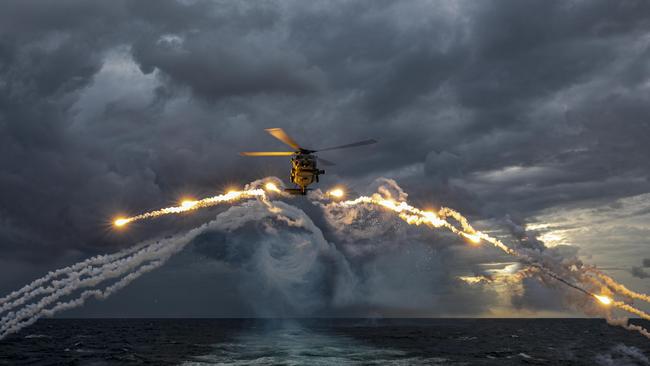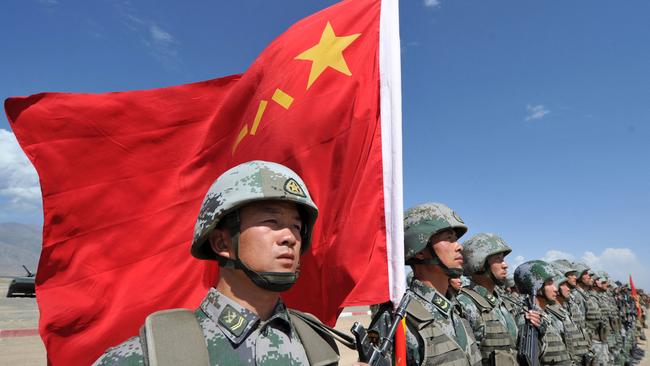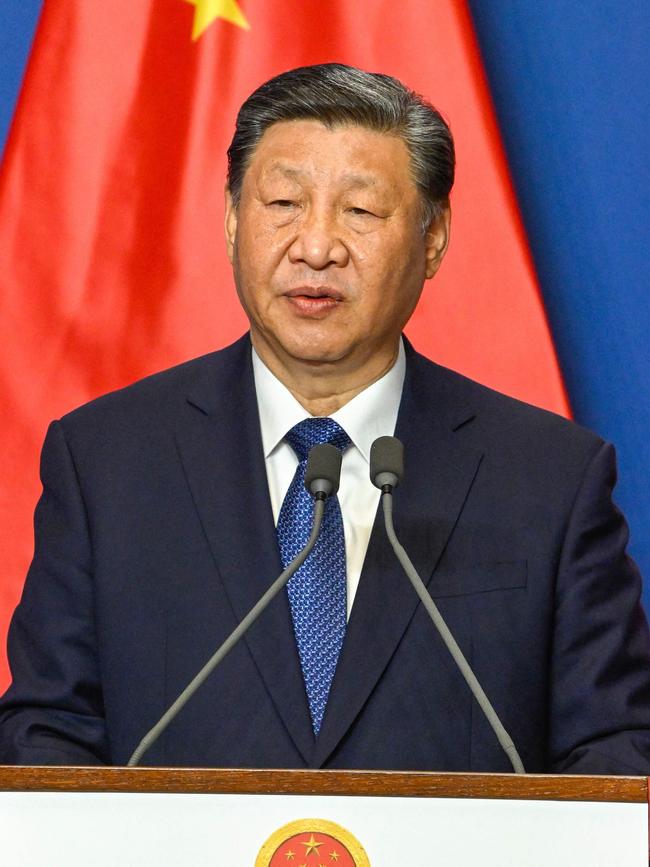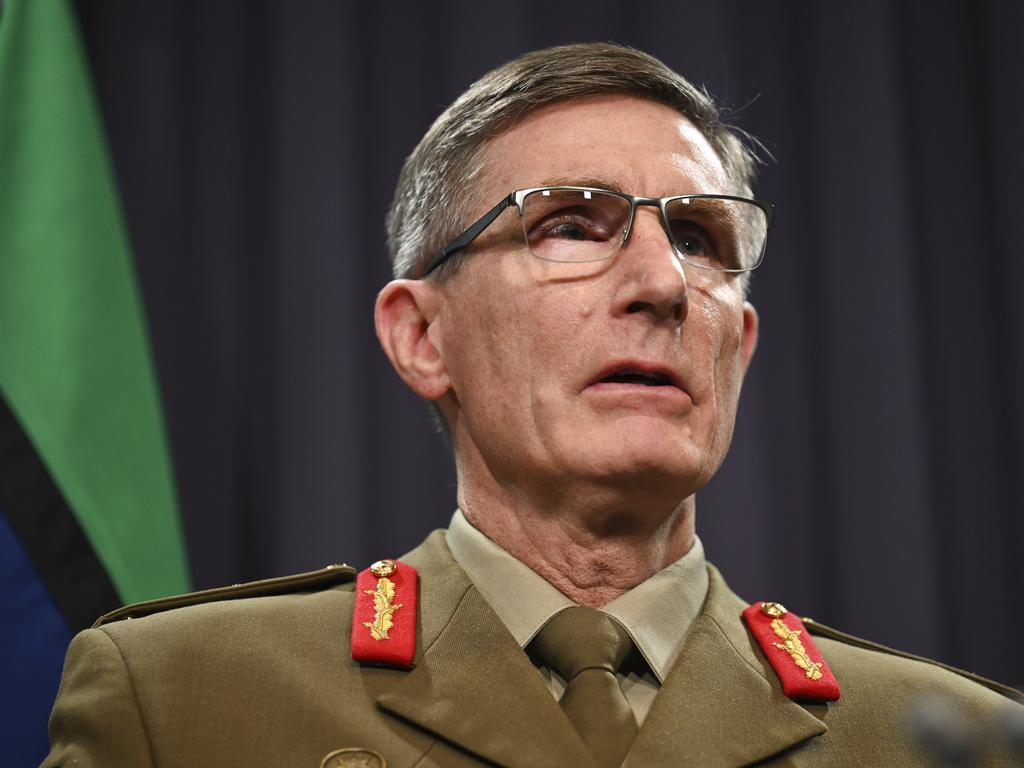Australia’s descent into a position of looming peril
In his first major mainstream media interview on defence policy after a long reign as the country’s most powerful bureaucrat, Mike Pezzullo says he is increasingly alarmed about the big picture of Australia’s response to the China threat.

Ask Mike Pezzullo about Australia and China and he delivers good news and bad. First the good. He says China is frustrated and puzzled by Australia’s refusal to bow to its military intimidation despite the increasingly lopsided defence capabilities of the two countries.
He says the latest confrontation, when a Chinese jet this week dropped flares dangerously close to an Australian naval helicopter in the Yellow Sea, was a renewed attempt by Beijing to intimidate Australia as part of a long-term strategy of “getting middle powers off the field” in northeast Asia.
Pezzullo, one of Australia’s most influential China watchers, says such chest-beating is proving counter-productive for Beijing.

“China wants to influence everyone’s perception of their resolve,” he tells Inquirer.
“Their original strategy was to peel everyone off to intimidate, particularly small and medium-sized powers, to demonstrate their resolve to use force and to say ‘we are not for turning’, whether it is an Australian ship or flight going through the region. But they see Australia is still patrolling up in the South China Sea and it must cause them to shake their heads and say: ‘Why isn’t our pressure working with these guys?’ I think it is puzzling them.”
But now the bad news. While Pezzullo admires the fact the Australian military has not taken a backward step in the face of China’s intimidation, he is increasingly alarmed about the big picture of Australia’s response to the China threat.
In his first major mainstream media interview on defence policy after a long reign as the country’s most powerful bureaucrat, Pezzullo says Australia faces a historic security dilemma or, as he calls it, “a position of looming peril”.
“Australia’s security dilemma is now acute,” he says.
“Force expansion should have occurred over the past 15 years as warning time counted down. Instead, the Australian Defence Force is still optimised largely for what was called 40 years ago ‘escalated low level conflict’.
“In a substantial conflict Australia would be hard placed today to defend itself without a substantial degree of force augmentation from the United States, particularly in a number of areas of capability deficiency – so much for defence self-reliance.”
Such harsh words matter when they are spoken by someone with the gravitas of Pezzullo.
The longtime secretary of the Department of Home Affairs and the Department of Immigration and Border Protection, Pezzullo was also the principal author of the 2009 defence white paper under the Rudd government. That white paper was the first to shine a bright light on the future military threat posed by a rising China and Pezzullo at that time was one of the key voices in Canberra trying to warn the China doves within the bureaucracy that Beijing was no longer a cuddly panda.

But the muscular promises of that 2009 white paper, including the doubling of Australia’s conventional submarine fleet from six to 12, the acquisition of eight new large frigates and a new fleet of patrol boats, never eventuated. Like so many grand defence promises, these plans were stymied by a lack of political will.
The 15 years of inaction in Australia since that white paper has coincided with the largest military build-up of any country since World War II and increasingly aggressive hegemonic behaviour from the South China Sea to the South Pacific.
During this time Pezzullo privately has gnashed his teeth at the lost opportunities for Australia, but as a senior public servant he had to keep his own counsel. Now he is speaking out because he can, but still in an understated public service style.
Pezzullo left the public service in November last year after a review found he had breached the Australian Public Service code of conduct by making partisan interventions during the 2018 Liberal Party leadership spills. Six months on, he wants to dip his toe back into the public policy debate but says he wants to remain apolitical and is reluctant to place blame on any one government or party for Australia’s defence failings.
But it is clear Pezzullo sees the period from 2010 to 2020 as a lost decade for Australia when political infighting within the Rudd-Gillard Labor governments and the Abbott-Turnbull-Morrison Coalition governments distracted Canberra from enacting the hard reforms on defence that were needed.
“We went into a situation of political turmoil from 2010 for about a decade with changes of prime minister and changes of defence ministers,” he tells Inquirer in an interview in Canberra.
“How we got to this position of looming peril is not a useful question for now. History will render that judgment. We have to do what we can with what we have or can quickly build.”
Pezzullo has written a thoughtful paper, The Long Arc of Australian Defence Strategy, to be published by the Australian Strategic Policy Institute next week, in which he pinpoints 2006-07 as the moment when the perception of China began to change within the defence establishment.
“At this stage, even before Xi Jinping (became president), we started to see significant (new) air and sea capabilities with very long-range, high levels of lethality, that only made sense in some kind of view that the Chinese might have that one day they might have to have a conventional engagement with the Americans,” he says.

“There was a drumbeat of escalating military spending, a focus on very capable maritime, especially naval forces and long-range air capabilities. It was clear that China wanted a military force that could operate a long way from its coast.”
Pezzullo likens the moment to the scene in the film Jaws when the character Brody first sees the size of the killer great white shark and says to shark hunter Quint, “You’re going to need a bigger boat.” He says: “It (China) was like the Jaws of war. We’re going to need a bigger boat.”
Pezzullo says the warnings on China that he wrote into the 2009 white paper have been validated by history and have accelerated further since Xi came to power. “All of that has come to pass and perhaps even more in more recent years.”
He says he was especially struck by public comments made in February last year by CIA director William Burns, who revealed that Xi had instructed his country’s military to be “ready by 2027 to conduct a successful invasion” of Taiwan. But Burns also cautioned that it was not clear whether Xi had decided to use military force for unification.
If China did choose to attack Taiwan, Pezzullo says, the US certainly would take military action to defend the island and it would be inconceivable that Australia would not also become involved militarily. “It is likely that we would become a combatant,” he says. “China would be in no doubt as to our geostrategic utility to the United States.”
Pezzullo puts the chances of a major conflict involving China at no more than 10 per cent at the moment, but he is gravely concerned if such a conflict were to erupt Australia would be poorly prepared.
In fact, Pezzullo says Australia is less self-reliant in its defence now than it has been ever since Australia’s modern defence policy was born with the 1986 Dibb review of Australia’s defence capabilities and Kim Beazley’s subsequent 1987 defence white paper. Although the concept of defence self-reliance harks back to the Fraser government in the mid-1970s, Pezzullo says it was the Beazley white paper of 1987 that enshrined it as “the organising principle of our defence strategy”. The quest for self-reliance was a natural evolution of Paul Dibb’s and Beazley’s renewed focus on the direct defence of the Australian continent after the US defeat in Vietnam in the early ’70s effectively ended the policy of “forward defence”.
“The 1987 white paper declared that Australia would not seek, and would not expect, to receive unrealistic – and therefore non-credible – levels of commitment to the defence of Australia by US combat forces,” Pezzullo says.

This did not mean the US would never come to Australia’s aid in the event of a major conflict, especially a nuclear war, but the policy of self-reliance recognised that a more isolationist US could not be relied on in all circumstances. It called for Australia to move towards a military force that could operate independently of the US.
Pezzullo says the concept of self-reliance has gone through various evolutions in defence policy across the years, each of which has progressively increased the focus on the need to defend Australia in the air-sea approaches further to the country’s north.
But the strategy of self-reliance was only ever going to be attained through high levels of defence spending to renew and expand Australia’s military in line with strategic developments. Pezzullo says the failure to do this, especially from 2010 when Australia needed to expand its forces substantially to meet the challenge of China, means the ADF’s force structure is still similar to what it was 40 years ago, notwithstanding advances in technology.
“We’ve got a force really that in its DNA has not expanded much since then,” he says. “There’s some additional lethality (because) of technological capability, obviously, that wasn’t around 40 years ago.
“But when looking at our forces today, it is largely six infantry battalions, 10 or 12 surface combatants depending on how you count them, six submarines, which are the (Kim) Beazley era submarines.
“Now, of course, technology has come along, and there’s been some terrific progress made in recent years around guided weapons, and we’ve finally decided to activate the decision that was announced 15 years ago to get land attack cruise missiles in the form of the Tomahawk. Obviously, the Joint Strike Fighters have also come on line, they’re far more capable than their predecessors, but the adversary has also got better capability.”
Pezzullo says that failure to implement the 2009 white paper was a turning point for Australia that has led to the current problems.
“The 2009 white paper stands in the arc of Australian defence strategy as the road not taken when we still had time,” he says. “A further 15 years on, Australia today has to contend with the very prospect of more substantial conflict … the Indo-Pacific strategic order has been transformed, US primacy has been challenged (while) China has accelerated its military expansion, including of its nuclear strategic forces, and has become more assertive and coercive in its behaviour.”
Pezzullo says if Australia were required to defend itself in a conflict involving China, it would need to ask for “uncomfortably significant” help from the US military in areas where Australia has failed to invest in capability, especially in missile defence.
“There are gaps in the numbers of platforms and their availability, and there are some key gaps like, for instance, missile defence, where we have got nothing. If you can’t shoot a missile, you can’t engage in missile defence.
“Despite having opted for self-reliant defence in the 1980s, in a major war Australia would find itself having to rely to an uncomfortably significant degree on US force augmentation. This is the price of not building the force that we needed as the warning signs flashed when we had time to do so.”
Pezzullo says the current ADF could handle a low-level conflict against a regional adversary “but that is cold comfort as no such conflict is in prospect”.
He comes to the grim but logical conclusion that if US military superiority in the Indo-Pacific were to “fade gradually or shattered suddenly”, Australia would be unable to defend itself in a war against China.
“If a major, well-armed regional power, unchecked by the US, were to decide that access to vast resources or land, or both, would be in its interests, Australia would not necessarily have the strategic, economic, demographic and military means to preserve its sovereignty and starve off subjugation,” Pezzullo says. “No amount of astute diplomacy, skilful statecraft or the building of regional architectures would offset that strategic shock … of a world where US primacy was a memory.’’
Luckily, he sees no prospect of Washington reducing its focus on the Indo-Pacific regardless of who wins the presidential race in November. He says the US across its history has shown a capacity to overcome internal political divisions and the challenge of China would not be underestimated by Donald Trump or a second Joe Biden administration.
He says the US would come to Australia’s aid in any modern conflict involving China, not least because safeguarding this continent would be “a vital strategic objective for the US, as a matter of its own cold, hard interests”.
Pezzullo says the Morrison and Albanese governments belatedly recognised the parlous state of defence and the threat posed by China and took steps to tackle this via Scott Morrison’s 2020 Defence Strategic Update and Anthony Albanese’s 2023 Defence Strategic Review. Although he says it was a lost opportunity for Australia not to have doubled its fleet of conventional submarines from six to 12 as was called for in the 2009 white paper, he is a strong supporter of the AUKUS plan to acquire nuclear-powered submarines.
For this and other reasons, Pezzullo says Australia will need to lift its defence spending substantially from the current 2 per cent of GDP to at least 3 per cent if the country is to move closer towards its long-stated aim of defence self-reliance.
“Faced with the credible prospect of the jaws of war leaping violently at us during this decade we are going to need a bigger force. Defence spending as a proportion of GDP should be increased quickly to at least 3 per cent,” he says.
Pezzullo says it will be a long journey for Australia to recover the lost opportunities from 15 years of relative inaction on defence capability, but at least the size of the challenge has now been recognised. “Remediation is under way,” he says. “How quickly or effectively (this happens) is something for another day.”
The Long Arc of Australian Defence Strategy by Mike Pezzullo will be published by the Australian Strategic Policy Institute next week.






To join the conversation, please log in. Don't have an account? Register
Join the conversation, you are commenting as Logout